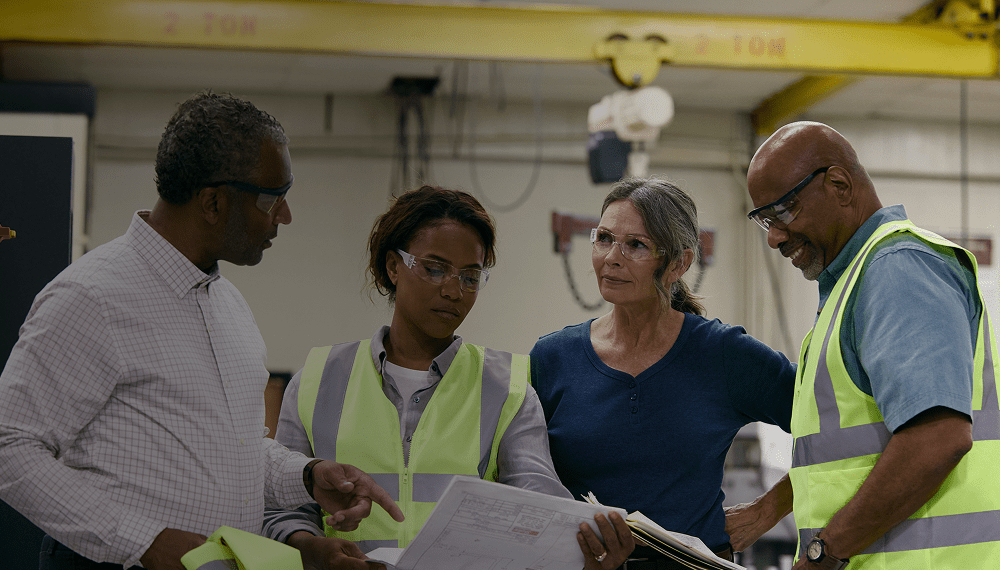Q&A with Clay Hoover, Jim Reese and Kelley Whalen: How employee engagement drives energy savings.

In our webinar, “Unlock Energy Savings: How Top Companies Benefit from Employee Engagement,” industry experts discuss innovative energy-saving programs and incentives available to businesses.
Here are some of the key insights that came out of this conversation with Clay Hoover, PE, Senior Program Manager, TVA EnergyRight® for Business and Industry, who recently sat down with Adtran’s Kelley Whalen and Ashland’s Jim Reese to discuss employee engagement.
Read on to learn more practical tips and real-world examples to help your business achieve its energy goals:
- The benefits of Strategic Energy Management
- Ideas for how to engage employees through recognition programs, incentives and active participation
- How Strategic Energy Management helps businesses secure capital for energy efficiency projects
- The community connection: reinvesting energy savings to support local initiatives
This interview has been edited for length and clarity. The views and opinions expressed throughout belong to the interviewees and do not necessarily reflect the official policy of the Tennessee Valley Authority.
Q: Clay, what is TVA EnergyRight’s Strategic Energy Management program, and how does it work?
A: Strategic Energy Management is a free two-year program that helps industrial businesses cut energy costs, boost profits and meet sustainability goals through expert-guided efficiency improvements. It gives you the tools needed to manage your energy in a coordinated way across your organization, helping your company increase profitability, create a competitive advantage, reduce environmental impact and support your community.
Q: Jim, what strategies have you used to engage your employees in energy efficiency?
A: Energy management can be a tough job, but it’s a whole lot easier when you build a team and get employees involved. Progress in energy efficiency is incremental — one step at a time. Over the years, we’ve tried different things, like employee incentive and recognition programs. When it comes to getting employees to support your program, you have to find your most stubborn naysayer and make that employee your ally. It comes down to this — what’s in it for your employees?
Q: Kelley, how does your team approach employee engagement?
A: At Adtran, we’ve had an energy program in place since 2005 that focused on employee awareness, but it was nothing like what we have now since joining the Strategic Energy Management program. Previously, we relied on infographics and word of mouth, and that was about it. However, once we became involved in Strategic Energy Management, we took our efforts to another level. We began using digital signage, corporate emails, banners and blogs to communicate more effectively and build credibility.
We also make sure to send out corporate emails that build confidence by sharing our successes. Sharing success is one of the most important things you can do to engage employees. People like to be part of a winning team. It resonates with employees when you have success, make improvements and demonstrate energy savings without making people uncomfortable.
Q: Kelley, what’s the most essential key to success for an energy-saving program?
A: To me, the triple bottom line — people, planet, profit — needs to be balanced. I refer to this as the sustainability zone, where all three aspects align to make sense. For instance, on a 90-degree day, I could use my control system to set everyone’s temperature to 80 degrees, which might be good for profit and the planet, but it wouldn’t be good for those working in those conditions. All three — people, planet, and profit—must align for a strategy to be effective. When we build credibility, we get the engagement and buy-in we need for the program to succeed.
Q: Jim, what about incentives for employees? Has that strategy worked for you?
A: We introduced an energy incentive program that worked pretty well. There was a fundraiser in this part of Western Kentucky, where they built a house and sold raffle tickets for $100 each, giving people a chance to win the house. We decided to tie this to our energy program. Anyone who submitted a viable energy-saving suggestion that could save at least $500 would receive a $100 gift card and a chance to win a house worth $300,000. Although nobody from our program won the house, it was an effective way to encourage participation.
Ultimately, we learned that the most important factor is not always significant incentives but small, incremental recognition. A simple pat on the back and a “thank you” can be very motivating.
We have a safety recognition program tied to environmental goals, including energy savings, which is integral to our sustainability goals. If an employee makes an energy-saving suggestion, they earn points. These points can accumulate toward extra vacation time, recognition items or even donations to charity. Last year, we donated over 1,500 meals to the community through this program.
Q: We saw the infographic you presented earlier, Kelley. Could you share a little bit about its origin? Did you build it yourself, or was it a collaborative effort with your energy team?
A: I was inspired by other infographics that I had seen at industry events, and I wanted to see if we could also use an infographic to convey our message. So, I involved our marketing team early on. I told them I wanted an infographic, and they helped create it.
Now, we update it yearly. It’s an easy way to convey our message. For example, in the top right corner of the infographic, you can see that we’ve saved 186 million kilowatts since 2005. In dollar terms, that’s about $14 million of energy costs that Adtran didn’t have to spend, all because we made small changes and implemented energy projects.
Q: Jim, what are some of the challenges you’ve encountered securing capital for energy efficiency projects, and how has Strategic Energy Management helped?
A: Securing capital for energy projects can be challenging, but Strategic Energy Management has helped us justify these projects by coupling energy savings with sustainability goals to make our case. For example, we had a project using Strategic Energy Management to show the environmental benefits of reducing greenhouse gas emissions, which helped us secure the necessary funding. It’s all about finding the right opportunities and building a strong case for investment.
Q: Kelley, how do employees at Adtran contribute to identifying energy savings?
A: Initially, it was just me, but after joining Strategic Energy Management, we engaged an energy team of everyday employees who provided valuable input. For example, one team member suggested creating an internal energy connect page, which has become a central hub for our energy policy, infographic and live energy data. Another example is when we moved a lab to a new location, reducing the number of cabinets from 40 to 12, thanks to the energy team’s involvement. These contributions have been crucial to our success.
Q: Jim, how do you encourage employees to share their ideas for energy savings?
A: We have a cross-functional energy team that meets regularly, and we also conduct audits with employees. By involving employees directly in these audits, they often come up with valuable suggestions. For example, one operator came up with a simple solution to prevent hoses from freezing in the winter, which ended up saving a lot of energy. It’s about going to the employees and actively soliciting their ideas.
Q: Jim, how does Ashland incorporate community involvement into its energy-saving initiatives?
A: We believe in reinvesting our energy savings back into the community, particularly in local schools. We’ve partnered with TVA to provide educational opportunities for at-risk students, helping them pursue careers in STEM fields. For example, one student who attended our diversity celebration is now working with us after completing an engineering degree. It’s not just about saving energy; it’s about making a long-term impact on the community.
Q: Kelley, how does Adtran use its energy savings to support the community?
A: We’re part of the Save It Forward initiative through Strategic Energy Management, where we commit to donating a portion of our energy savings to a local school. In our first year, we saved 1.9 million kilowatts, translating to about $95,000; half of that will go toward the school. They’ll use the funds for an energy or air quality project to benefit students. We’re happy to give back and help improve the community.
Q: What has been the most impactful project for your energy savings, Kelley?
A: Joining Strategic Energy Management had the most significant impact because it involved all employees. We could combine all these efforts with our demand load shed project, which built our energy dashboard. The load shed project automatically skims the peak off our energy use without employees even noticing, and the energy dashboard allows everyone to see our live energy data. This combination has been a game-changer for us.
Let’s talk.
Do you want to learn more about how employee engagement can be a powerful tool in driving energy savings?
Contact us here to start the conversation.
Clay Hoover, PE, Senior Program Manager, TVA EnergyRight® for Business and Industry
Clay has been with TVA for more than 15 years. In his current role, he leads the design and operations of Strategic Energy Management programs for TVA’s commercial and industrial customers. Clay builds innovative programs that leverage energy efficiency to improve schools and communities in the Valley.
Jim Reese, Senior Operations Manager, Ashland, Inc.
Jim is the Senior Operations Manager with Ashland, Inc., in Calvert City, Kentucky. With more than 40 years of experience, Jim has a wealth of operations and energy management knowledge. He’s been with Ashland for nearly 28 years, where he started an energy program 25 years ago. Ashland is now a global chemicals company with a significant focus on energy efficiency and sustainability. Over the years, the company has saved nearly 12 trillion BTUs and over $42 million in energy costs and reduced CO2 emissions by 58,000 tons.
Kelley Whalen, Energy Manager, Adtran
Kelley is the Energy Manager for Adtran in Huntsville, Alabama. He’s a recognized leader in the field, having won multiple AEE awards, including International Energy Manager of the Year. Kelley brings more than 31 years of experience in energy management and a unique approach to engaging his employees in energy efficiency. Since 2005, he’s helped Adtran reduce energy consumption on campus by nearly 50%.



